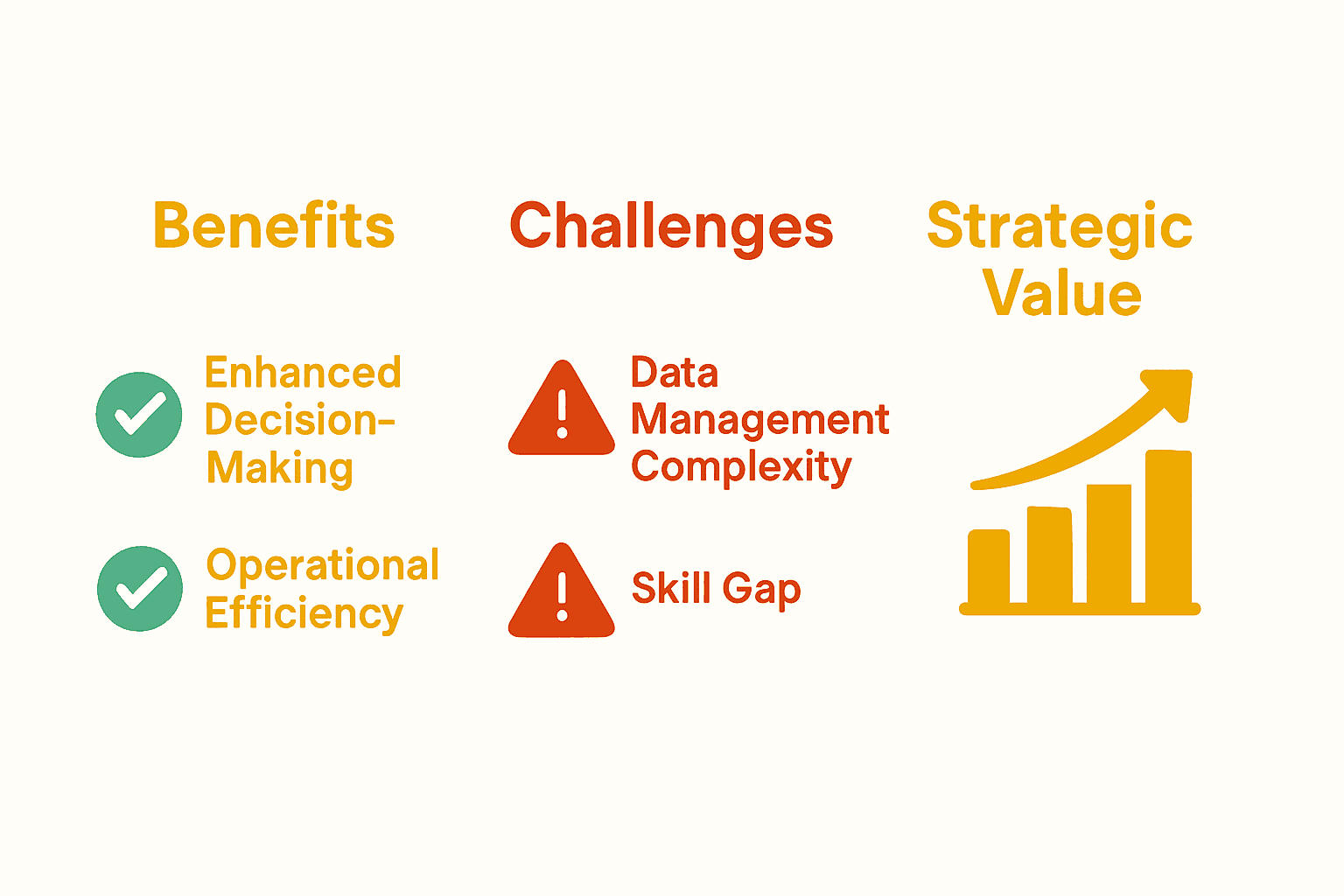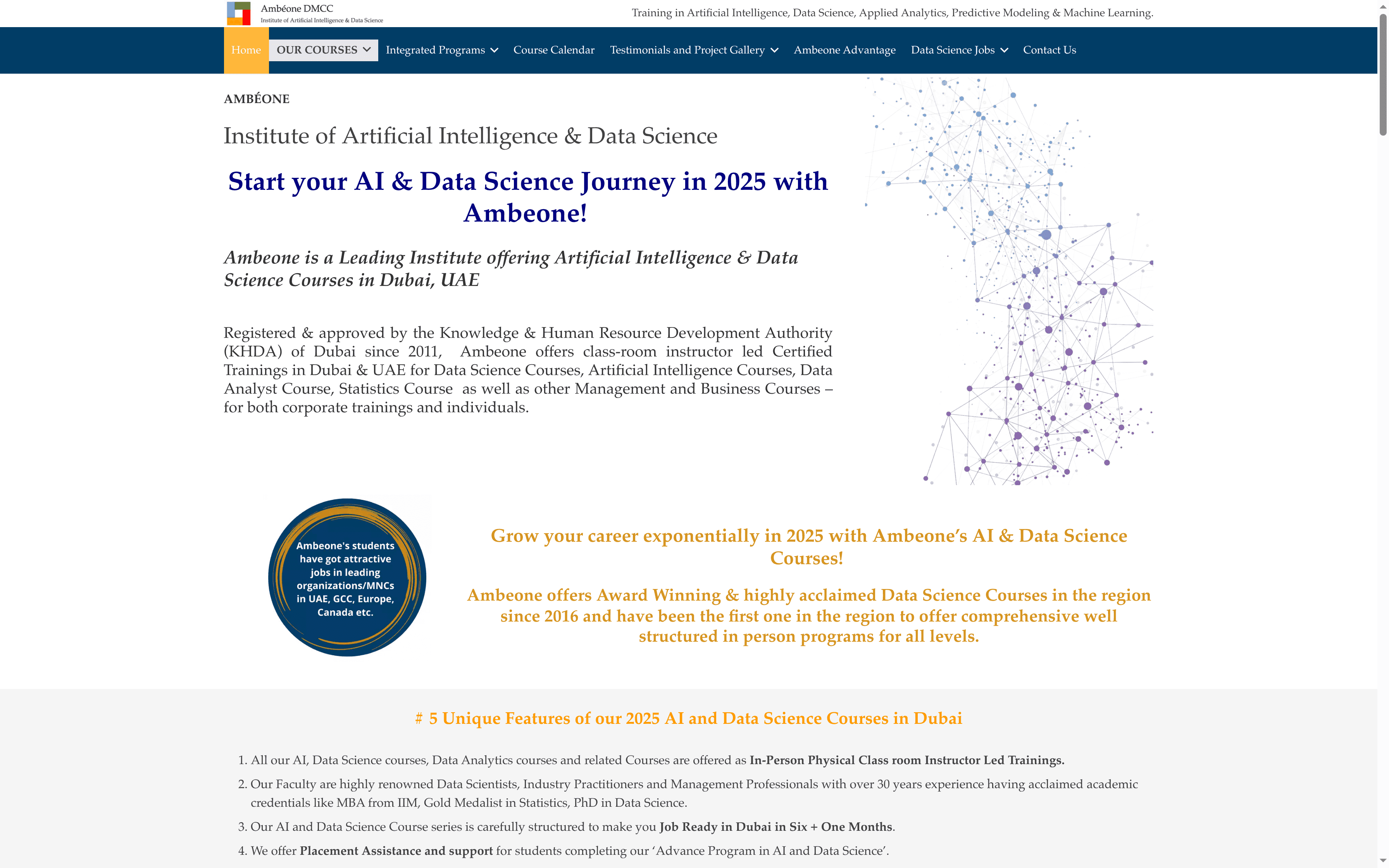The Essential Guide to Applications of Applied Analytics
More than 90 percent of american organizations now rely on applied analytics to guide key decisions. As data becomes central to every industry, understanding how raw numbers turn into real-world strategies is more important than ever. Applied analytics is reshaping business, healthcare, and retail by translating massive datasets into insights leaders can use with confidence. This guide explains the essentials, methodologies, industry examples, and challenges so you know how analytics delivers true competitive advantage.
Table of Contents
- Defining Applied Analytics and Core Concepts
- Key Types and Methodologies Explained
- Industry Use Cases: Business, Healthcare, Retail
- Benefits and Limitations for Organizations
- Implementation Challenges and Best Practices
Key Takeaways
| Point | Details |
|---|---|
| Applied Analytics Definition | It transforms raw data into actionable insights, enhancing strategic decision-making across industries. |
| Key Components | Involves data collection, processing, statistical modeling, predictive insights, and practical recommendations. |
| Methodologies Available | Includes descriptive, diagnostic, predictive, and prescriptive analytics to inform decision-making. |
| Benefits vs. Challenges | Offers enhanced decision-making and operational efficiency, but faces issues like data management complexity and skill gaps. |
Defining Applied Analytics and Core Concepts
Applied analytics represents a sophisticated approach to transforming raw data into meaningful, actionable insights that drive strategic decision making across industries. According to research from arxiv.org, applied analytics is a multi-dimensional discipline that integrates analytical, cognitive, and computational processes to extract valuable information from complex datasets.
Applied analytics goes beyond traditional data analysis by focusing on practical problem solving and generating implementable recommendations. As outlined in the comprehensive survey from arxiv.org, this field encompasses advanced methodologies that enable organizations to leverage industrial big data for strategic advantage. The core objective is to convert intricate data patterns into clear, executable strategies that can optimize performance and drive innovation.
At its fundamental level, applied analytics involves several key components:
- Data Collection: Gathering relevant information from multiple sources
- Data Processing: Cleaning, organizing, and preparing data for analysis
- Statistical Modeling: Using mathematical techniques to identify patterns and trends
- Predictive Insights: Developing forward-looking projections based on historical data
- Practical Recommendations: Translating analytical findings into actionable business strategies
Professionals engaged in applied analytics must possess a unique blend of technical skills, including statistical knowledge, programming expertise, and strategic thinking. The field demands proficiency in tools like Python, machine learning algorithms, and data visualization techniques to transform complex information into comprehensible, strategic insights.
By integrating computational power with human expertise, applied analytics provides organizations with a robust framework for making data-driven decisions that can significantly enhance operational efficiency, competitive positioning, and overall organizational performance.
Key Types and Methodologies Explained
Applied analytics encompasses a diverse range of methodological approaches designed to extract actionable insights from complex datasets. According to a comprehensive survey from arxiv.org, the primary methodologies include mathematical optimization, data mining, machine learning, probabilistic modeling, and advanced simulations.
These methodological frameworks can be categorized into several fundamental types:
- Descriptive Analytics: Analyzing historical data to understand past performance and trends
- Diagnostic Analytics: Investigating why specific outcomes occurred
- Predictive Analytics: Forecasting future trends and potential scenarios
- Prescriptive Analytics: Recommending specific actions based on analytical insights
Research from arxiv.org highlights the importance of specialized techniques like clustering, forecasting, and simulation across various domains. These techniques enable organizations to transform raw data into strategic intelligence, providing nuanced insights that drive informed decision making.
Professionals in applied analytics must develop expertise in multiple methodological approaches, understanding how to select and implement the most appropriate technique for specific business challenges. This requires a sophisticated blend of statistical knowledge, computational skills, and strategic thinking to effectively translate complex data patterns into meaningful, actionable recommendations.
The evolution of applied analytics methodologies continues to accelerate, with emerging technologies like artificial intelligence and machine learning expanding the boundaries of what’s possible in data-driven strategic planning. Organizations that can effectively leverage these advanced methodological frameworks will gain significant competitive advantages in an increasingly data-centric business landscape.
Industry Use Cases: Business, Healthcare, Retail
Applied analytics has revolutionized decision-making across multiple industries, transforming complex data into strategic insights. According to research from arxiv.org, there are at least ten distinct application domains where data-driven prescriptive analytics delivers significant value, including critical sectors like healthcare and manufacturing.
Business and Manufacturing Applications
In the manufacturing sector, applied analytics enables unprecedented operational optimization. Research from arxiv.org highlights several transformative use cases:
- Smart Factory Visibility: Real-time monitoring of production processes
- Machine Fleet Management: Predictive maintenance and performance tracking
- Proactive Maintenance: Identifying potential equipment failures before they occur
Healthcare Innovations
Healthcare represents another domain where applied analytics creates remarkable impact. Organizations can now leverage advanced analytical techniques to:
- Predict patient risk factors
- Optimize treatment protocols
- Improve resource allocation
- Enhance diagnostic accuracy

Retail Sector Transformations
Retail businesses are increasingly adopting applied analytics to understand consumer behavior. By analyzing purchasing patterns, customer demographics, and market trends, retailers can:
- Personalize marketing strategies
- Optimize inventory management
- Predict demand fluctuations
- Design targeted promotional campaigns
These industry applications demonstrate how applied analytics transcends traditional data analysis, providing actionable intelligence that drives strategic decision-making and competitive advantage across diverse sectors.
Benefits and Limitations for Organizations
Applied analytics offers organizations a powerful toolkit for transforming data into strategic insights, but the journey is not without complexity. Research from arxiv.org reveals a nuanced landscape of benefits and challenges that organizations must carefully navigate.
Key Benefits of Applied Analytics
The advantages of implementing applied analytics are substantial and far-reaching:
- Enhanced Decision-Making: Enabling data-driven strategic choices
- Operational Efficiency: Streamlining processes and reducing waste
- Predictive Capabilities: Anticipating market trends and potential risks
- Resource Optimization: Allocating resources with unprecedented precision
Critical Organizational Challenges
However, arxiv.org research also highlights significant limitations organizations must address:
- Complex Data Management: Integrating diverse data sources
- Methodological Complexity: Requiring sophisticated analytical expertise
- Real-Time Analysis Demands: Maintaining up-to-the-minute insights
- Talent Acquisition: Finding professionals with requisite technical skills
Successful implementation of applied analytics requires a strategic approach that balances technological investment with human expertise. Organizations must develop robust data infrastructure, cultivate analytical talent, and create a culture that values data-driven decision-making.
Ultimately, the most successful enterprises will be those that view applied analytics not as a technical solution, but as a comprehensive strategic capability that transforms raw information into competitive advantage. By understanding both the immense potential and inherent challenges, organizations can design more effective, intelligent analytical strategies that drive meaningful business outcomes.

Implementation Challenges and Best Practices
Implementing applied analytics is a complex endeavor that requires strategic planning and sophisticated organizational capabilities. Research from arxiv.org reveals that successful implementation hinges on addressing multiple interdependent challenges across technological, human, and procedural dimensions.
Key Implementation Challenges
Organizations typically encounter several critical challenges when deploying applied analytics:
- Data Heterogeneity: Managing diverse and inconsistent data sources
- Technical Infrastructure: Building robust analytical ecosystems
- Skill Gap: Developing teams with advanced analytical capabilities
- Cultural Resistance: Overcoming traditional decision-making paradigms
Best Practices for Successful Implementation
Arxiv.org research recommends several strategic approaches to mitigate implementation risks:
- Establish Clear Data Governance: Create comprehensive frameworks for data management
- Standardize Analytical Workflows: Develop consistent methodological approaches
- Implement Continuous Monitoring: Regularly assess and refine analytical processes
- Foster Cross-Functional Collaboration: Encourage communication between technical and business teams
Successful implementation requires a holistic approach that balances technological sophistication with organizational adaptability. Companies must invest not just in tools and technologies, but in building a data-driven culture that values analytical insights and empowers decision-makers to leverage complex analytical frameworks.
Ultimately, the most effective applied analytics strategies transcend technical implementation. They represent a fundamental reimagining of how organizations generate value, transforming raw data into strategic intelligence that drives competitive advantage and sustainable growth.
Unlock the Power of Applied Analytics with Expert Training
Applied analytics transforms complex data into actionable insights but mastering the methodologies and overcoming implementation challenges can feel overwhelming. If you are aiming to enhance your skills in areas like data mining, predictive analytics, or prescriptive analytics, it is crucial to gain hands-on knowledge and practical expertise. This article highlights key industry applications and the strategic value applied analytics delivers across business, healthcare, and retail.

Take the next step toward becoming a proficient applied analytics professional by exploring tailored in-person courses at Ambeone. Our KHDA-approved training programs provide in-depth coverage of AI, machine learning, and data science fundamentals with a focus on real-world business applications. Whether you want to refine your technical skills, bridge the talent gap, or lead data-driven projects effectively, start your journey with our comprehensive offerings found in the Uncategorized Archives – Ambeone. Act now to transform your career and gain the competitive edge that today’s data-driven market demands.
Frequently Asked Questions
What is applied analytics?
Applied analytics is a discipline that transforms raw data into actionable insights for strategic decision-making across various industries. It integrates analytical, cognitive, and computational processes to derive meaningful information from complex datasets.
What are the key components of applied analytics?
The key components of applied analytics include data collection, data processing, statistical modeling, predictive insights, and practical recommendations. Each component plays a vital role in deriving strategic insights from data.
How is applied analytics used in healthcare?
In healthcare, applied analytics is used to predict patient risk factors, optimize treatment protocols, improve resource allocation, and enhance diagnostic accuracy, enabling more informed and efficient decision-making.
What challenges do organizations face when implementing applied analytics?
Organizations often face challenges such as data heterogeneity, technical infrastructure limitations, skill gaps, and cultural resistance when implementing applied analytics. Addressing these challenges is crucial for successful deployment.

